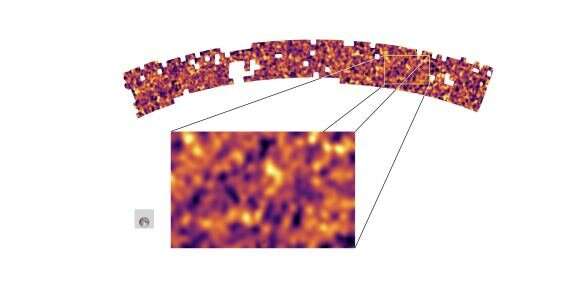https://phys.org/news/2020-08-universe-lookeven-cosmologists.html
The edge of the observable universe mapped onto a celestial sphere.
Credit: Planck Collaboration
This doesn't mean the universe is perfectly smooth at large scales. Even at the most distant edge of the visible universe, there are small fluctuations. Observation of the cosmic microwave background (CMB) shows minor variations in temperature caused by areas of higher and lower density that existed in the early universe. This is precisely what we would expect. In fact, the scale of CMB fluctuations allows us to measure dark matter and dark energy.
The distribution of galaxies also isn't perfectly smooth. They are grouped into superclusters separated by voids of mostly empty space. The small density fluctuations seen in the CMB laid the seeds for galaxy clusters to form. According to the LCDM model of cosmology, early galaxies were drawn toward more dense regions. As the universe expanded over billions of years, the current structure of superclusters and voids formed. Since the scale of CMB clusters gave rise to galaxy clusters, measurements of the CMB allow us to predict the size of superclusters. In other words, the level of smoothness in the early universe makes a prediction about the smoothness of galaxy clusters we should see.
But a new study of galaxies finds that our prediction doesn't quite agree with what we observe. The Kilo-Degree Survey (or KiDS) has mapped more than 31 million galaxies within 10 billion light-years. The survey covers about half the age of the universe and gives us the positions of these galaxies and their statistical 'clumpiness.' Using the KiDS data, a team has found that galaxies are about 10% more homogeneous than predicted. The universe is smoother than we thought, and it isn't clear why.

Part of the KiDS map, showing variations in cosmic density. Credit: B.Giblin, K.Kuijken and the KiDS team
But for now, the best option is to keep gathering data. The answer is out there, and with careful observations like these, we will eventually find it.
Recommend this post and follow Sputnik's Orbit




No comments:
Post a Comment